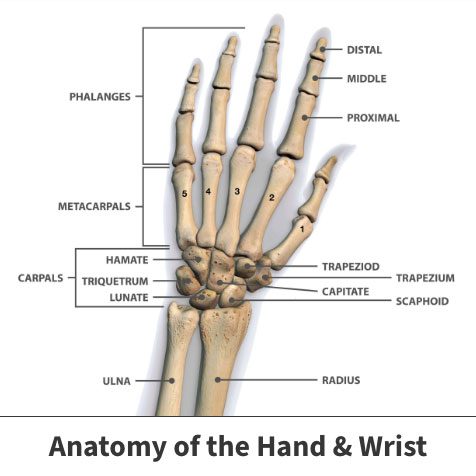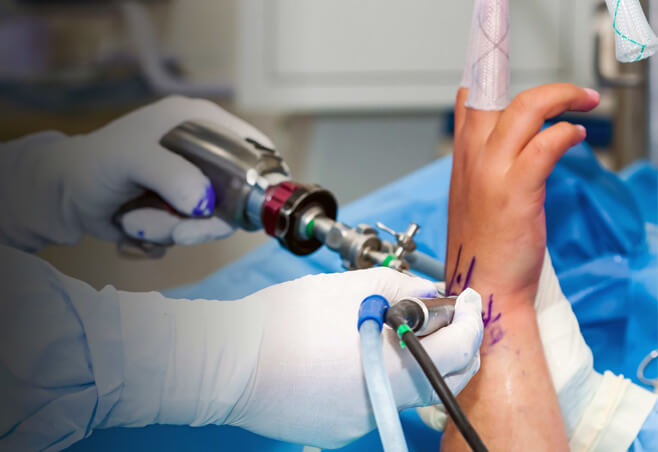Wrist arthroscopy
Wrist arthroscopy is a procedure that uses a small camera, known as an arthroscope, to diagnose and treat problems within the wrist joint. The wrist is a complex joint with eight small bones and many connecting ligaments. Arthroscopic surgery is used to diagnose and treat several conditions of the wrist, including chronic wrist pain, wrist fractures, ganglion cysts, and ligament tears.
Anatomy

The wrist is one of the most complicated joints in the body. On the hand side of the wrist, there are two rows of bones at the base of the hand. There are four bones in each row. The bones in these rows are called the carpals. The long thin bones of the hand radiate out from one row of carpals and form the basis of the fingers and thumb.
The radius and the ulna are the two bones of the forearm that form a joint with the first row of carpals. The ends of the bones are covered with an elastic tissue called cartilage. Cartilage creates a slick surface that enables the bones to move smoothly.
About
Wrist arthroscopy is a surgical procedure used to diagnose and treat problems within the wrist. This procedure uses a small, fiber-optic camera called an arthroscope that allows your surgeon to see inside the joint without making a large incision into the muscle and tissue. Arthroscopic surgery is used to both diagnose and treat conditions of the wrist, such as chronic wrist pain, wrist fractures, ganglion cysts, ligament tears, and carpal tunnel syndrome.
During the procedure, your surgeon makes small incisions (known as portals) through the skin in strategic positions around the wrist joint. These incisions are very small – less than half an inch long. The arthroscope, roughly the size of a pencil, is inserted through the incisions, along with several surgical instruments. The images are projected onto a monitor, allowing your surgeon to see what is happening in the joint easily.
Diagnosis
A diagnostic arthroscopy is typically used to determine your diagnosis. Before an arthroscopic diagnosis, your Florida Orthopaedic Institute physician will:
- Examine your hand and wrist
- Review your medical history
- Perform tests that locate the pain in your wrist
- Order tests such as X-rays and MRI scans to help determine the cause of your pain
The actual arthroscopic diagnostic procedure is done by making two or more small incisions at the back of the wrist where the arthroscope is inserted. After the surgery, the incisions are closed with a small stitch, and a dressing is applied. Sometimes a splint is used.
After the procedure, your physician will have images of your wrist, giving them a better sense of your diagnosis.

Treatment
Arthroscopic surgical procedures are used to treat several wrist conditions, including:
- Chronic wrist pain – Arthroscopic exploratory surgery is used to diagnose the cause of chronic wrist pain when other tests do not provide a clear diagnosis. Usually, there are areas of inflammation, cartilage damage, or other findings after a wrist injury. In some cases, after the diagnosis is made, the condition can also be treated arthroscopically.
- Ganglion cysts – Ganglion cysts commonly grow from a stalk between two of the bones in the wrist. During an arthroscopic surgical treatment, your surgeon removes the stalk, which can help prevent the cysts from returning.
- Ligament/TFCC tears – Ligaments are fibrous bands of connective tissue that link two bones together and provide stability and support to the bones. The TFCC (triangular fibrocartilage complex) is a cushioning structure within the wrist. A fall on an outstretched hand can tear ligaments, the TFCC, or both, resulting in pain. During arthroscopic surgery, the surgeon can repair the tears.
Videos
Related specialties
- Basal Joint Surgery
- Carpal Tunnel Syndrome
- De Quervain's Tenosynovitis
- Dislocated Finger
- Distal Radius Fracture (Broken Wrist)
- Dupuytren’s Disease
- Flexor Tendonitis
- Fractured Fingers
- Functional Nerve Transfers of the Hand
- Ganglion Cysts
- Hand & Finger Replantation
- Hand Nerve Decompression
- Hand Skin Grafts
- Nerve Pain
- Peripheral Nerve Surgery (Hand) Revision
- Revascularization of the Hand
- Rheumatoid Arthritis of the Hand
- Sports Wrist & Hand Injuries
- Sprained Wrist
- Sudden Acute Finger, Hand & Wrist Injuries
- Targeted Muscle Reinnervation (TMR)
- Tendon Transfers of the Hand
- Thumb Ulnar Collateral Ligament Injuries
- Trigger Finger
- Ulnar Neuritis
- WALANT (Wide Awake Local Anesthesia No Tourniquet)
- Wrist Fractures
- Wrist Tendonitis
